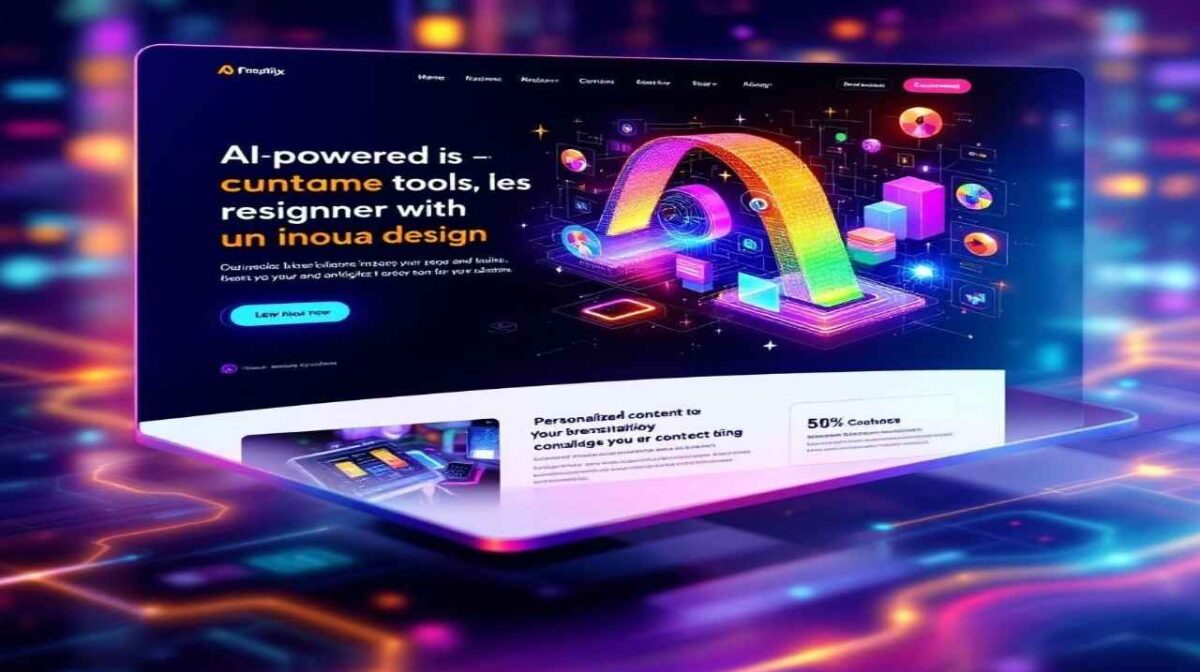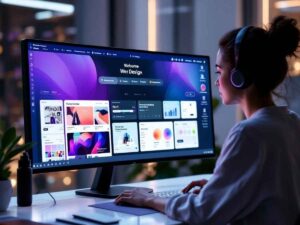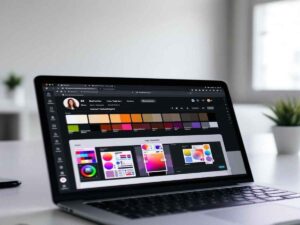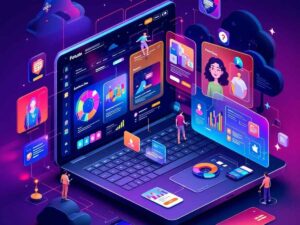The Future of AI in Web Design: Automation Trends and Innovations

Web design is undergoing a massive transformation, powered by the rapid advancements in AI in Web Design and automation. These technologies have evolved from mere conveniences to essential tools for creating, developing, and maintaining websites. From streamlining design workflows to crafting hyper-personalized user experiences, AI in Web Design is reshaping the web design landscape for both businesses and creators alike.
This post explores the future of AI in Web Design, highlighting how AI and automation are revolutionizing customer experiences, increasing efficiency, and providing designers and developers with the tools to stay competitive in a fast-paced digital world.
The Rise of AI in Web Design
What is AI-Driven Web Design?
AI-driven web design employs artificial intelligence to create and manage websites. It leverages machine learning algorithms to understand user needs and suggest design elements that align with the intended outcome. These tools can even generate layouts, typography, and color schemes with minimal human intervention.
Machine Learning and Design Automation
Machine learning plays a pivotal role in design automation by “learning” from historical data and user interactions. For example:
- Color palette recommendations based on industry trends
- Layout suggestions optimized for usability
- Typography enhancements designed for better readability

Examples of AI-Powered Design Tools
AI-powered tools like Wix ADI and Bookmark are revolutionizing web design by using AI algorithms to auto-generate responsive, aesthetically pleasing websites in moments. These tools cater to designers and non-designers alike, removing the barrier to entry for anyone wanting a professional-looking site.
Impact on Traditional Workflows
AI is shifting web design from static templates to dynamic, personalized user experiences. For instance:
- Websites can now adjust color schemes and layout designs based on user preferences or even the time of day.
- AI personalizes website content in real time, ensuring that every viewer sees an experience tailored specifically for them.
How Automation Is Revolutionizing Web Design
Automated Web Design Tools
Tools like Elementor and Webflow simplify the process of web design by automating key aspects, such as:
- Creating responsive layouts
- Pre-built templates
- Integrated content management systems (CMS)
Automation frees up designers to focus on creativity rather than repetitive tasks, like resizing images or fixing inconsistencies across devices.

Efficiency and Scalability
One of the most profound impacts of automation is its ability to create scalable websites quickly. With automated tools, designers can manage multiple projects simultaneously without compromising on quality.
Time and Cost Savings
By automating labor-intensive processes (e.g., coding headers manually), designers save time and businesses save costs. These efficiencies can make high-quality web design accessible to startups and small businesses with limited budgets.
Real-World Examples
Companies like Shopify are leveraging automation to help small businesses build and launch e-commerce websites in a fraction of the time it used to take. Entire agencies are using platforms like Webflow to complete client projects faster, helping them take on more clients without overextending their team.
Key Trends in AI and Automation for Web Design
AI-Powered Personalization
Personalization is where AI truly excels. AI can tailor website content, layouts, and even products displayed, based on:
- User demographics
- Browsing habits
- Geographic location
This results in increased engagement and improved conversion rates. For example, e-commerce websites like Amazon use algorithms to suggest products that feel uniquely handpicked for the user.
Automating UX Design
AI-driven tools can conduct automated A/B testing to determine the optimal design for a website. These tools use real-world user data to tweak and optimize user interface (UI) designs for an intuitive user experience (UX).
Predictive Design Analytics
Predictive analytics systems use past data to forecast future design trends or user behaviors. By analyzing website traffic and user interactions, AI can suggest changes that preemptively align with new market trends.
Integration with IoT
The Internet of Things (IoT) is another frontier where automation meets web design. Imagine a smart refrigerator sending its owner recipes and redirecting to a recipe website that’s personalized to their dietary preferences. Such intelligent linkages are made possible through the integration of AI, automation, and IoT.

The Future of AI-Powered Design Software
Advancements in AI Design Software
AI design tools like Adobe Sensei harness artificial intelligence to perform advanced editing, craft layouts, and even suggest design elements. Tools like these are becoming indispensable not just for professional designers but also for anyone looking to create high-quality visuals quickly.
Collaboration Tools for Teams
Platforms like Figma and Miro now incorporate AI in Web Design features that enable teams to collaborate more effectively on web and graphic design projects. AI-powered suggestions save time on redundant design revisions.
AI’s Future Role in Web Design
Emerging AI tools aim to make web design fully accessible to non-designers. Imagine a world where small business owners, with no prior tech experience, can create a polished, fully responsive website in under an hour.
Challenges and Limitations
While AI advances design efficiency, creativity remains its limitation. Human oversight is essential to ensure designs remain aligned with brand nuance and vision.

Benefits of Web Design Automation
Boost Efficiency
Automation reduces repetitive tasks, such as correcting the alignment of elements or resizing assets, allowing designers to focus on creativity.
Cut Costs
By streamlining processes, businesses save money on labor and development costs.
Design Consistency
Automated tools ensure brand guidelines are met across multiple pages, maintaining a consistent look and feel.
Enhanced Interaction
Automated components, like chatbots and predictive text, enhance user engagement. Chatbots, for instance, can respond to visitors 24/7, boosting satisfaction and interaction rates.
Challenges and Considerations
Balancing Creativity and Automation
AI might design efficient websites, but it lacks human creativity. Tasks like storytelling, conceptualization, and emotional resonance require input from skilled designers.
Ethical Concerns
AI relies heavily on data collection. Designers must ensure compliance with data privacy standards, such as GDPR or CCPA, to protect user information.
User Acceptance
Some users may resist AI-driven designs if they feel the changes are too automated or impersonal. Designers must ensure that automation complements—not replaces—the human touch.

How to Prepare for the AI and Automation Shift
Stay Adaptable
Learn and experiment with AI-focused tools like Wix ADI or Webflow. The more you’re exposed to these platforms, the better you can integrate them into your workflow.
Upskill
Consider online courses or certifications in AI technology for web design, such as those offered by LinkedIn Learning, Coursera, or Udemy.
By staying informed and open to change, professionals can unlock AI’s potential while retaining the creative flair that makes web design an art.
Start Redesigning Tomorrow’s Websites with AI Today
AI in Web Design is no longer just a futuristic concept; it’s a current tool delivering unparalleled efficiency, creativity, and optimization. Integrating AI into your workflow will allow you to create websites that are truly next-generation. Are you ready to elevate your web design strategy? Explore AI-driven design tools today and share your thoughts in the comments below!
Frequently Asked Questions (FAQ)
- What is AI-driven web design?
AI-driven web design leverages artificial intelligence tools to optimize and streamline the website creation process. These tools can automate tasks like layout creation, enhance user experience, and provide tailored solutions based on data analysis, helping designers deliver cutting-edge websites more efficiently.
- How can AI improve website functionality?
AI can enhance website functionality by personalizing user experiences, predicting user needs through machine learning, and improving navigation and accessibility. From chatbots to predictive search, AI ensures a seamless and engaging experience for visitors.
- Do I need technical expertise to use AI design tools?
Not necessarily! Many AI design tools are user-friendly and designed for individuals with different levels of expertise. Whether you’re a beginner or a seasoned professional, these tools often provide templates, tutorials, and intuitive interfaces to guide you.
- What are some examples of AI tools for web design?
Some popular AI tools for web design include Adobe Sensei, Wix ADI, and Figma’s AI plugins. These tools assist with tasks like layout suggestions, image optimization, and even generating design elements based on your project’s goals.
- Why should I implement AI in my web design process?
Integrating AI in your web design process saves time, boosts creativity, and ensures optimized results. AI tools help identify user behavior patterns, automate time-consuming tasks, and enhance the overall quality and functionality of your designs—empowering you to stay ahead in a competitive industry.





